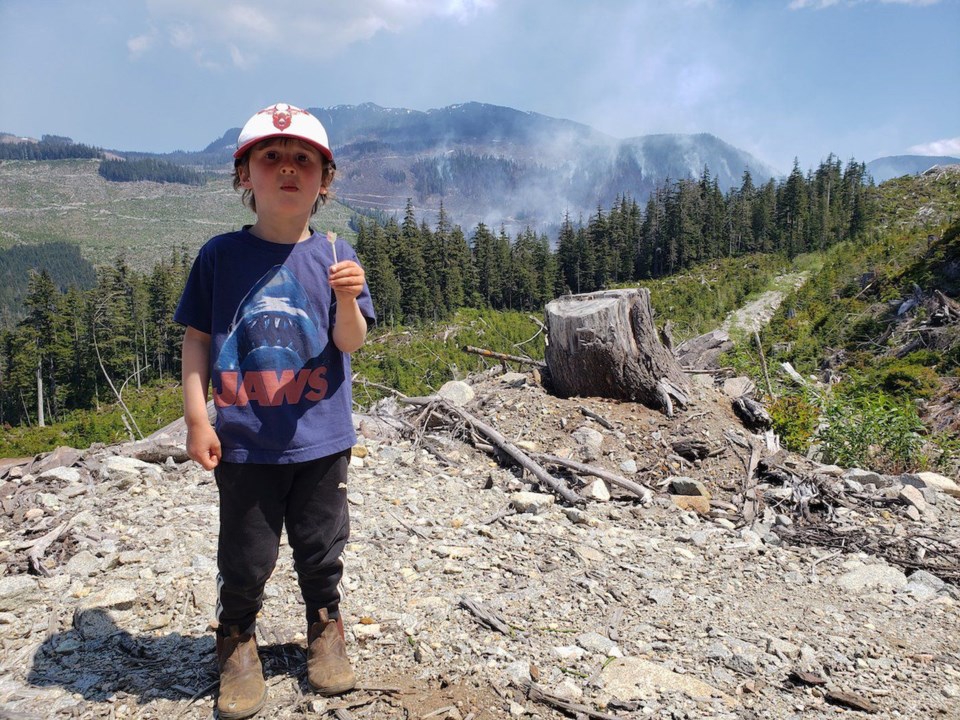Sayward, B.C., resident Shannon Briggs scrolls through family photos on her computer.
She pauses to contemplate a surreal image of her four-year-old son Stokely standing on a bluff, holding a half-eaten lollipop while a mountain ridge in the background behind him burns up.
“It's crazy. Kids are so oblivious,” Briggs observes, shaking her head at the juxtaposition of her son’s apparent lack of concern and the gravity of the situation.
“But talk about a case of ‘this is how we live now,’” Briggs says.
The picture was taken on Day 4 of the Newcastle Creek wildfire. It was sparked May 29 less than six kilometres from the Village of Sayward on North Vancouver Island.
Briggs and other family members living in the rural municipality had driven to the opposite side of the valley to get a sense of the fire’s direction of travel.
“There was so little information in the first couple of days that we didn’t really know what was going on,” Briggs says.
The family spent the first week of the blaze analyzing wind direction and providing each other regular smoke forecasts based on where they were situated in the community.
Ten days later, the 208-hectare fire is still burning. But as of June 5, BC Wildfire Service stated the blaze is no longer ‘out of control.” Consequently, neither is Briggs’ stress level.
But both are vulnerable to a surge at a moment’s notice, Briggs says.
“The wind simply has to change direction.”
No evacuation alert or order has been issued for the Newcastle wildfire because it hasn’t posed a significant threat to the community’s homes or infrastructure to date.
But it certainly doesn’t mean the wildfire isn’t posing a serious danger, Briggs notes.
The first evening of the fire, ash particles rained down from the sky as she and her partner Chris raced to plant and water trees on their small regenerative farm on the outskirts of the community before he departed for work at a remote camp the next day.
The apocalyptic smoke conditions that frequently kept her and the kids trapped indoors during the early stages of the fire have eased, Briggs says.
But now, even on “good days,” the air quality is poor and changes for the worse rapidly depending on the wind, time of day, temperature and whatever other variables impact wildfire smoke, she says.
If conditions are bad and must-do chores can’t wait, Briggs, who has mild asthma, dons a respirator to round up her chickens and ducks, work her gardens or do her side gig of tending her neighbour’s small herd of water buffalo.
Wandering her property looking like she’s withstanding a wartime gas attack isn’t a recently developed habit and not one she’ll be dropping any time soon.
Briggs was forced to take up the practice immediately after her family moved to their “dream property” in the summer of 2018.
Weeks after their arrival, their new home was blanketed in smoke as B.C. experienced its second “record-breaking” wildfire season, the first occurring just the year before.
Then, in 2021, an extreme heat wave arrived, followed by a savage wildfire season that wiped the small B.C. town of Lytton off the map and blanketed the province in smoke.
“This is at least the third year where I've had to wear a respirator,” Briggs says.
This summer hasn’t even officially begun, and media reports are already suggesting it’s going to be Canada’s worst fire season ever.
“I mean, how many more record-breaking fire seasons can we have?” she asks.
But despite the fear of fires, their small farm is their forever home, Briggs says.
“We’re never leaving.”
Instead, she and Chris are constantly doing all they can to drop the risk.
They’ve fireproofed their property, installed a tin roof on the house, created a fire break around their home and religiously mow the high grass in a large perimeter around their home. They have hoses and large water tanks, and practise firefighting using the creek on their property as a water source if it's not already dry.
She’s got grab bags packed and at the ready, and she’s prioritized lists of tasks based on how long she has before evacuating.
At worst, it will mean her and Chris grabbing the kids and the dogs, setting the farm animals free and driving off in the truck before the only road out of town is blocked. If there’s more time, she can park the tractor in the centre of the gravel driveway so it doesn’t burn down with the barn.
“People ask me all the time, ‘What would you take?’” she says.
“But it really depends. Do I have a day? A couple of hours? Twenty minutes?”
Sifting through her digital albums, many summer photos over the past five years depict family activities or outings with a telltale haze of smoke in the backdrop. One from their first summer on the farm shows Chris posing proudly with their young daughter Dia next to a new fire pump they bought.
Briggs was raised in Sayward and never experienced any impacts from wildfires during her youth. But her kids are young enough that the climate impact of summer fires and choking smoke are part of their regular experience, Briggs observes with some sadness.
“They’ve kind of grown up with it.”
Rochelle Baker / Local Journalism Initiative / Canada's National Observer




